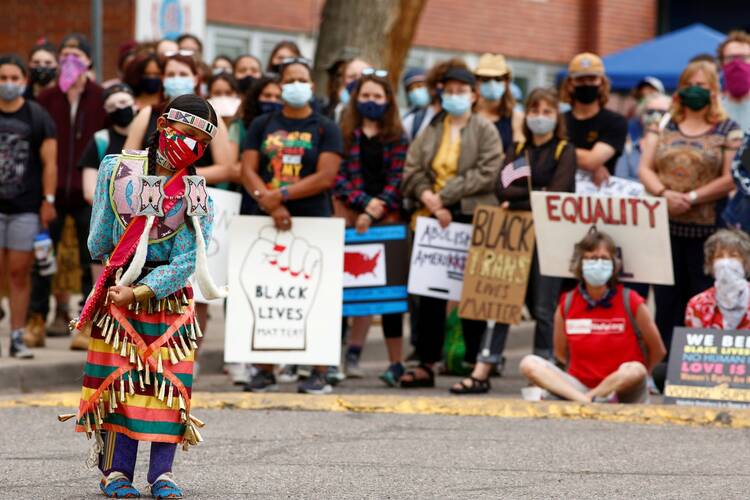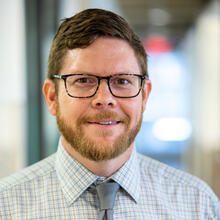When she was 5, Stacy M. Allen moved to the United States from Panama. She describes her family as middle class. “We had a decent place to live,” she said. Her mother, who was working on her master’s degree, knew she would have more opportunities in the United States.
It was quite an adjustment for Ms. Allen and her two older sisters. “I was trying hard to blend in,” she said.
“I don’t present as Latina, so people didn’t perceive me that way,” said Ms. Allen, who chairs the Young Adult Catholics of African Descent in the Archdiocese of Galveston-Houston. As a child, she began hiding her Latino heritage. In Spanish class, she stopped answering questions.
The United States is going through a national examination of conscience on the question of race, and the Latino community is no exception.
“There’s an assumption that because I present as Black, I can’t be Latina,” Ms. Allen said. Yet, she noted, 95 percent of the people who were brought to the Americas from Africa as slaves went to Latin America.
“We are everywhere,” she said. “But it’s been hard to feel embraced entirely by the Latino community.”
The United States is going through a national examination of conscience on the question of race, and the Latino community is no exception. Far from being a monolithic group, Latinos are diverse in race, culture and language. Going deeper into America’s racial tensions means asking difficult questions, according to Ms. Allen.
“Start asking yourself, are you a racist? How am I being anti-racist? How am I using my privilege to fight racism?” Ms. Allen, an attorney in Houston, said in an interview with America. “When you’re painting your angels, do they all look like you? In what way are you choosing voices that look like you?”
Far from being a monolithic group, Latinos are diverse in race, culture and language.
Recently, Ms. Allen joined other church leaders for a virtual panel discussion on how the Latino community should approach racism. More than 350 attended the Spanish-language panel on Aug. 5, organized by the National Federation of Catholic Youth Ministry and V Encuentro.
Key leadership positions in the church do not represent the demographic diversity of the country, according to Patricia Jiménez, the communications coordinator for V Encuentro. As part of the V Encuentro process, a four-year initiative from the U.S. bishops, participants throughout the country asked Catholics in their community about their experiences with the faith and knocked on doors in neighborhoods to hear what people had to say.
“We’ve taken a step back and really taken a look at ourselves,” she told America. “As we take leadership in the church, we’re being conscious of who’s at the table. We have a responsibility. Our silence adds to the culture of systematic racism. It’s not just speaking, but action.”
Discrimination came up often as an ongoing issue during the V Encuentro, said Ms. Jiménez. The Latino community does not always get an equal share of resources at the parish level, she said. Still, she applauded the U.S. bishops for their efforts, including their pastoral letter against racism, “Open Wide Our Hearts.”
Over the years, Latino ministry has tended to talk more about diversity of nationality than about race.
“We all have to realize that we have certain levels of discriminative and biased actions,” Ms. Jiménez said. “It starts with an individual, in our own hearts. We have to remember that each person is created in the image and likeness of God. We can go deeper.”
Over the years, Latino ministry has tended to talk more about diversity of nationality than about race, Alejandro Aguilera-Titus, assistant director for Hispanic Affairs at the U.S. Conference of Catholic Bishops, told America. He pointed to sayings like “No seas indio” (“Don’t be an Indigenous person”) that reveal that whiteness is favored in Latin America. “There is more excitement when a child is born on the lighter side of the color spectrum,” he said.
“Today, some of us act more like Spanish conquistadores and some of us are treated more like slaves,” Mr. Aguilera-Titus said. “We need to break through that on the individual and systemic level. We have to realize we live in a system that privileges white people.”
The many cultures and races in the Latino community can come together to be a “gente puente,” a bridge people.
It is critical to address the issue as Latinos take a greater leadership role in the church, he said. The many cultures and races in the Latino community can come together to be a “gente puente,” a bridge people, that unite the community despite differences in race, socioeconomic status and education levels, Mr. Aguilera-Titus said.
“We need to envision a church and a country that has a place for everybody,” Mr. Aguilera-Titus said. “We can do things in a way that can change the dynamics of racism and exclusion. We need to dig deep into our Gospel reality and discover new ways of seeing and relating across culture and race. We need to learn each other’s stories.”
Finding a Place for the Indigenous
Growing up in Guatemala, Juanatao Cano did not learn to speak Spanish until he was a teenager. Mr. Cano’s ancestry is Mayan and Q’anjob’al is his nation and native tongue. He is proud of his heritage now, but he was ashamed of it when he began attending school in Huehuetenango.
In seventh grade, the other children made fun of him because he had plastic shoes. He came home after the first day and asked his dad if they could buy leather shoes so he could fit it. But his father told him they could not afford it. The next day, he went to school in his bare feet.
“What happened to this monito?” the teacher asked, referring to Mr. Cano as a monkey. They told him to go back to the mountains. “You have to think white, act white, embrace white if you want to succeed,” he said.
As a teenager, Juanatao Cano would ask himself, “Why was I born Indian? Why wasn’t I born white?”
As a teenager, he would ask himself, “Why did I come to this world? Why was I born Indian? Why wasn’t I born white? Even within the Latino community, I was discriminated against. It’s about who has the light skin.”
In the 1980s, during Guatemala’s civil war, the government bombarded entire villages, Mr. Cano said. General Efraín Ríos Montt, who took power in a military coup in 1982, accused Indigenous Mayans of harboring insurgents and conducted mass murders in villages.
“My relatives, they were just killed in the mountains. I saw my uncle’s body lying in the bushes,” Mr. Cano said. “They were just killing all of us because we were Indians. Where was God? All of us kids saw all of these dead bodies. I could not survive there.”
He came to the United States in the late 1980s when he was 20. At first, he was an undocumented immigrant but eventually received refugee status. “When I arrived here, that’s when my healing process started,” he said.
“We have to be open to the Indigenous and Black communities.”
While some welcomed him at his parish, he said “the Latino priests saw me as a means to clean the bathroom.” Still, it was less traumatic than Guatemala.
“I wanted a place I could live in harmony, where the Indiginous people weren’t being wiped out,” Mr. Cano said. “I was looking for a better place where I could be myself.”
At first, he worked in the textile industry, but began going to night school to learn English. Mr. Cano became a citizen, got a degree in mathematics and became a high school teacher. He went on to graduate school for school administration and is now working on his doctorate at Pepperdine University.
“Let’s be open to the spirit of God. We should be helping each other and respecting each other,” Mr. Cano said. “That’s the Holy Spirit helping us, always looking forward. We have to be open to the Indigenous and Black communities.”
Healing Racism in Families and Church
Growing up in California and Arizona, Andrew Rivas said he could go weeks without seeing anyone who was not Latino. “Looking back, I can see there was racism that I wasn’t aware of at the time,” he told America. “But I still had the comfort of knowing that I was surrounded by a culture that was my own.”
Mr. Rivas, the executive director of the California Catholic Conference, remembers first being confronted with racism while studying for his law degree at Catholic University in Washington, D.C.
“I needed new glasses, so I went to an eyeglasses store on K Street,” he said. The woman there asked if she could help, and then led him to a wall display. But when a Black man entered, she treated him differently. The man said he just wanted to look around, but she shadowed him. That upset the man, and he eventually left.
The woman then told Mr. Rivas, “If you don’t keep an eye on them, they’ll rob you blind.” He left.
“The Holy Spirit is stirring. Young people from all shades are coming together.”
“That’s when I had the epiphany. I’m not white. I’m not part of the dominant culture,” he said. “But I’m also not Black. I cannot fathom what it’s like when people assume you’re a thief.”
He has noticed racism in his own family. Growing up, his elders told him to, for example, “learn from the Jew. The Jew knows business.” He has nieces and nephews who are Black and Latino. They have confided in him that their peers do not see them as Latino, but only as Black.
At school, one of his other nephews pointed to his Black nephew and said, “Don’t mess with me. This is my cousin.” The implication, Mr. Rivas explained, was that other students should fear his Black nephew because of his race. Confronting racism requires humility and introspection, he said.
“The church plays the most important role of getting to the social goal of equality,” he said. “We provide the community a place to talk to one another. It takes the church and spiritual leaders to talk about forgiveness and understanding and love. That’s how you get to equality.”
Marilyn Santos, assistant director for the U.S. bishops’ Committee on Evangelization and Catechesis, noted that the oppressed often become the oppressors. In New York, for example, Mexican immigrants were treated horribly by other Latino immigrants. Dominicans and Puerto Ricans are also often pitted against each other. In some churches in the United States, she said, Spanish-language Masses used to be celebrated only in the basement.
“There’s this realization that collectively we in the Latino community have not taken the time to address this,” she told America. “It’s like our dirty little secret. We know it’s wrong, but we don’t talk about it. But racism is a rejection of God.”
Healing will come about only when people acknowledge racism in their own families and in themselves, Ms. Santos said. But the recent calls for racial justice give her hope.
“The Holy Spirit is stirring. Young people from all shades are coming together. They are so diverse,” she said. “For a long time, significant change has needed to happen. We’re banning together, and there is action behind the protests.”










